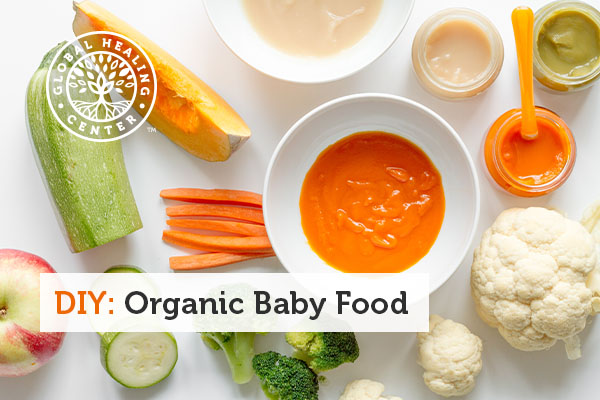How to Make Your Own Organic Baby Food

If genetically-modified and chemically-laden produce can cause adverse health effects in adults, imagine what it can do to an infant. Yet, many people who will buy their own organic produce also reach for conventional baby food when shopping for their little ones. Thankfully, making your own organic baby food is simple and can be quite enjoyable.
To make the best organic baby food, you will need to start with the best ingredients. If you can, grow it yourself. But if not, be sure to purchase the right produce. Buy local, organic produce whenever possible in order to maximize the nutritional benefits and freshness.
Local foods aren’t only more fresh, they support local organic farmers who are bucking the traditional system in an effort to bring you healthy food. If local organics aren’t an option, find a grocery store with a good selection of organic produce. When you get it home, no matter where it’s from, wash it well.
What Ingredients are Best?
The ingredients for your homemade organic baby food are simple: fresh produce. Some fruits and vegetables will need a little liquid added. If this is the case, choose breast milk in the event you are nursing. If not, you may use water.
To Cook or Not to Cook?
If the fruit or veggie you are using is hard (potatoes, apples, etc.), cook them just long enough to soften. Puree your produce, adding a little liquid if necessary. You don’t need the fancy baby food machine many retailers are hawking right now; a blender or food processor will work fine. With softer vegetables, like cooked sweet potatoes, even a fork will get the job done.
Fresh Does Not Mean Store it for 2 Months
When it comes to fruits and vegetables, fresh is best. The sooner you can get your baby food made and fed to your child the better. As produce is stored, the level of nitrates within grows. Either plan to make only what your child will eat in one sitting or consider freezing what you don’t use. Ice cube trays are a great idea for freezing small portions.
Here are a few additional tips and tricks when making your own organic baby food:
- Get creative. Combine fruits for new unique flavors. Eating is a brand new experience for your child and their face will display how exciting new flavors can be.
- If you’re not raising a little vegetarian, you can also make baby food from meats like chicken and salmon. Be certain, however, that the meat is organic and cooked to proper temperatures.
- You can even make organic cereals. For instance, buy organic brown rice and process it into a fine flour. Then, add water or breast milk and cook.
- Don’t sweat it. You can easily make baby food to match what you are making the rest of the family. If you are making green beans to go with dinner, put a small amount in the food processor for baby. There’s no need to make separate meals every time.
Preschoolers who eat a conventional diet have up to six times greater concentrations of pesticide residue in their bodies. Infants are even now being born with GMO toxins in their blood. We owe it to these children to take control of their health. We can’t rely on the food companies to do it for us.
†Results may vary. Information and statements made are for education purposes and are not intended to replace the advice of your doctor. If you have a severe medical condition or health concern, see your physician.

Dr. Edward Group, DC
FOUNDER | HEALER | ADVOCATEDr. Group, DC is a healer and alternative health advocate, and an industry leader and innovator in the field of natural health who is dedicated to helping others. He is a registered doctor of chiropractic (DC), a naturopathic practitioner (NP), and proud alum of Harvard Business School and MIT Sloan School of Management. Dr. Group, DC is the founder of Global Healing – a mission and vision he has shared through best-selling books and frequent media appearances. He aims to spread his message of positivity, hope, and wellness throughout the world.










